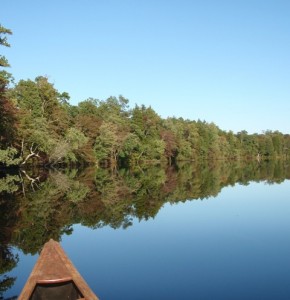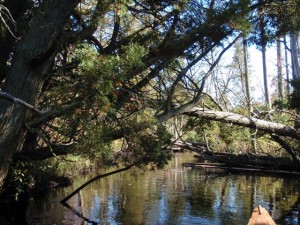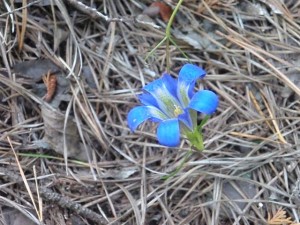Pine Barrens Paddling
This goes under the Busman’s Holiday catergory. Over the weekend, I joined some friends from the Pittsburgh area to canoe in the Pine Barrens of New Jersey. The Pine Barrens were really hit hard during Hurricane Irene, and we weren’t sure what to expect. The State Forest had closed a couple streams because there was no way to get help into areas in case of emergency. Fortunately, my friend researched which rivers were open, and the State re-opened the Mullica and Batsto the day we arrived.
We started on the Mullica River above Atsion Lake (where we camped). It looked okay where we put in, but we soon hit many obstructions and had to really work to get through. It seemed like we spent the day clearing brush and dragging over blowdowns to stay in the River. However, when I reviewed my photos, there were several areas where we paddled uninhibited. Much of this section is very intimate, not even as wide as a canoe is long. We were covered with mud and brush, and we were beat when we reached the campground. However, after a shower and supper we were revived enough to sit by the campfire and plan the next day’s trip.
We spent the next two days paddling more leisurely rivers. We did the Wading and Oswego Rivers. The Oswego, in particular, was so beautiful and secluded that it took our breath away. We paddled most of the day in silence and only spoke to each other when we were close enough to converse quietly. It was an experience I will never forget.
We saw an immature Bald Eagle one morning as we started our trip. Wood Ducks flew up in front of us as we came around bends in the river. At one place, I called Chickadees right down to the branches overhanging our canoes as we glided under.
While eating lunch one day, Megan found this beautiful blue flower. When I got home, I keyed it out as the Pine-barren Gentian Gentiana autumnalis. This is a endangered wildflower found in pine barrens down the east coast of the United States. Quite a discovery for us.
At another stop, while eating wild cranberries, we discovered a field of Pitcher Plants Sarracenia purpurea. These carnivourous plants hold rain water. The inside of the pitcher-shaped flower is slick and insects can’t crawl out. When insects enter, they are trapped and drown. Probably, as the insects break down in the reservoir it begins to smell and attract flies and more insects. The protiens from the insects can be absorbed by the plant. Another one of those fascinating adaptations that never ceases to amaze me.
I experienced some new Pine Barrens Rivers, and around the campfire, my friends and I made plans for next year’s excursions.




